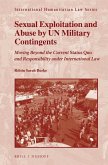Why is child sexual abuse committed primarily by men and male adolescents, unlike other forms of child abuse? Is child sex offending, rather than being a deviant masculine sexual practice, related to normative masculine practices, that is, practices structured on dynamic and changing relations of power? Using a practice-based sociological approach, the relationship between masculinities, sexualities and child sexual abuse is analysed and the power/powerlessness theory is developed to explain the predominantly male problem of child sex offending. The theory postulates that, because the social construction of masculinities involves the construction of dynamic and changing relations of power between men, men's lives are characterised by a combination of power and powerlessness. The book argues that an offender's experiences of powerlessness as a result of his relationships with other men is the key to understanding child sex offending, since sexuality is a key social practice for the alleviation of experiences of powerlessness and for establishing relations of power with other men. In particular, the theory argues that a man's particular attachment to the link between sexuality and experiences of masculinity and power will be a key factor for determining how he does sex and whom he chooses as a sexual partner. In the final chapter, the theory is tested through a re-analysis of offender interviews.
Hinweis: Dieser Artikel kann nur an eine deutsche Lieferadresse ausgeliefert werden.
Hinweis: Dieser Artikel kann nur an eine deutsche Lieferadresse ausgeliefert werden.







